
According to the Centers for Disease Control and Prevention (CDC), close to 4.5 million dog bites occur annually in the United States. These dog bite statistics will help you understand where the most instances commonly occur and what you can do about them.
The saying, “A dog is a man’s best friend” is often true. Dogs are the most popular pet in the United States, and the majority are loyal companions and beloved members of the family. About 69 million U.S. households own dogs — that’s over 76% of American pet-owning homes.
However, every dog can bite — even well-loved family pets — and not every bite will be a playful nip.
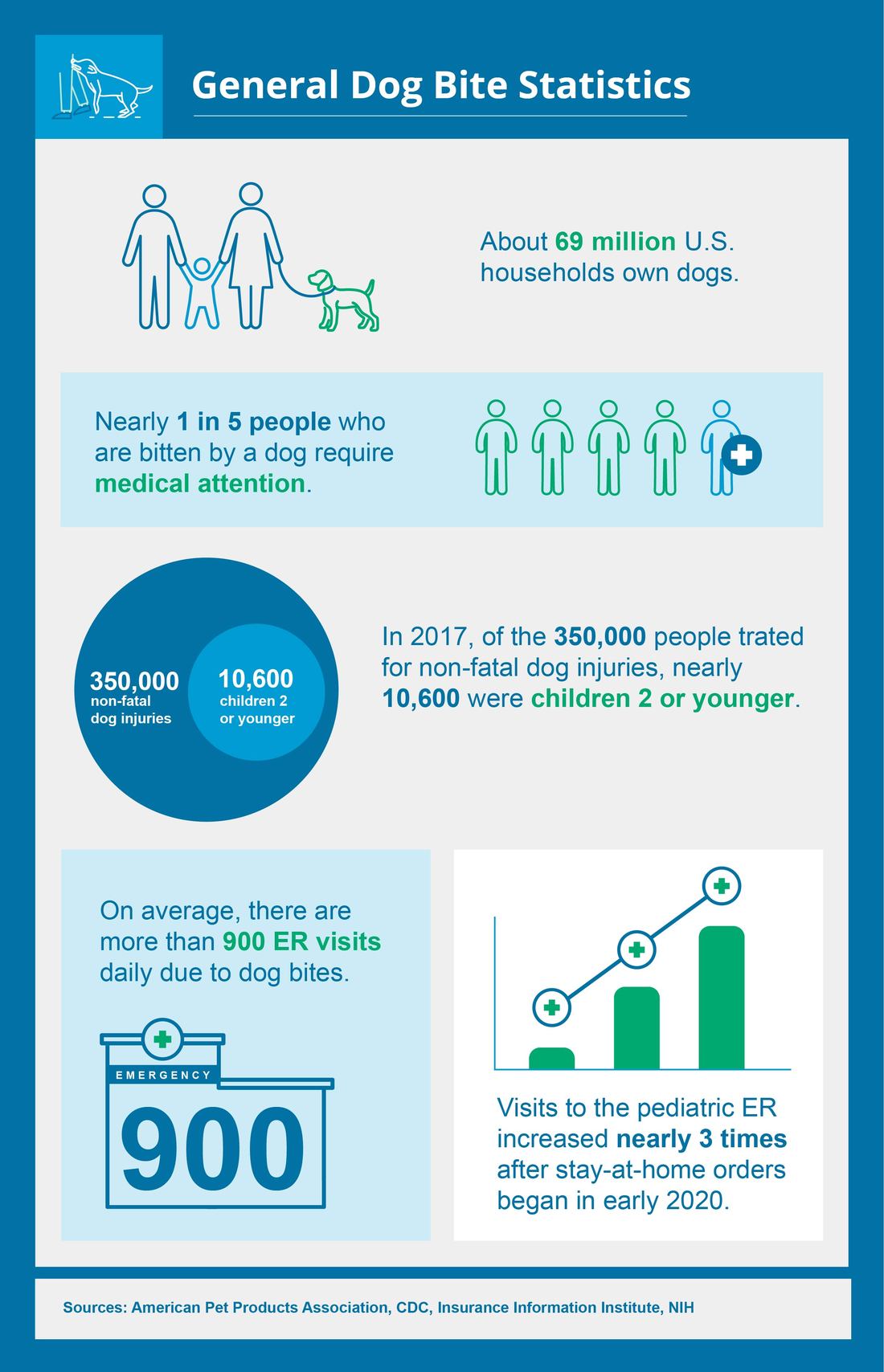
Injury isn’t the only concern with dog bites. In addition to emotional trauma, dog bites can be fatal. Rabies still kills around 59,000 people worldwide every year, and many of these rabies deaths originate with dog bites. In countries with poor dog vaccination programs, the rabies virus is a deadly threat, especially in areas with high populations of street dogs.
Data highlights how the combination of physical characteristics and bite capability are usually decisive factors in a specific breed of dog’s “risk to own.” Specifically, dogs with “short, wide heads” weighing “between 66 and 100 pounds” were most likely to bite.
According to DogBites.org, the following breeds cause the most fatalities. It’s important to note that mixed-breeds are tracked according to their predominant breed. If the predominant breed is unclear, they are tracked in the mixed breed category. Additionally, the majority of breeds are classified by appearance, not genetic testing. This means that some breeds may be misidentified.
Pit bulls
Mixed breeds
German Shepherds
Terriers
Rottweilers
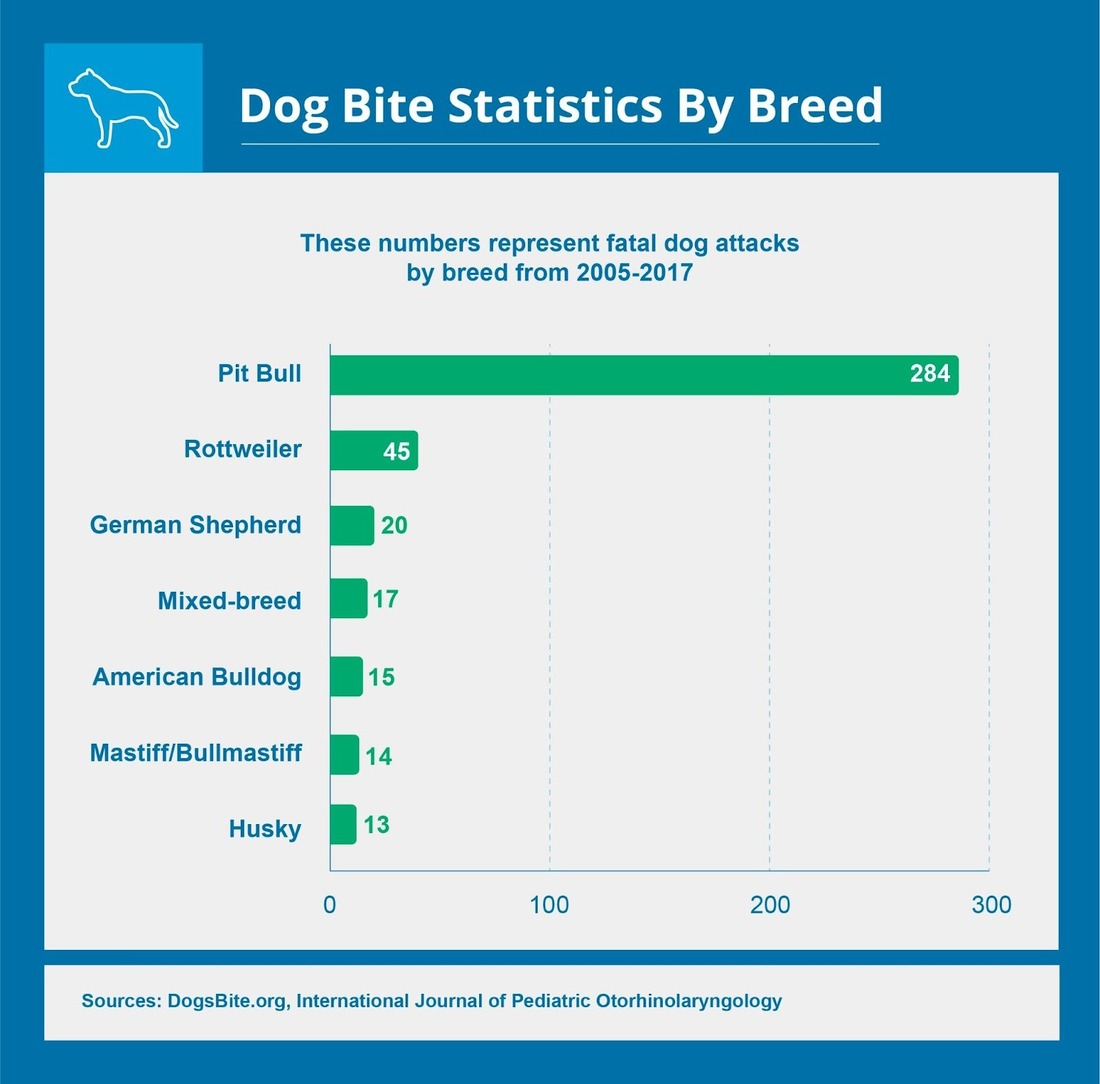
These fatalities are due, in part, to these breeds’ ability to cause more damage per bite. While other breeds, like rough collies, miniature poodles, and miniature schnauzers, have higher odds of aggressive behavior, they’re less powerful and therefore less likely to cause serious harm.
In 2020, pit bulls caused 72% of all fatal dog attacks. And, based on a 2018 study, pit bull bites are almost always the most severe out of all dogs.
Between 2005 and 2020, dogs killed 568 Americans. Pit bulls led to 67% of those deaths.
Pit bulls were 31% more likely to attack an unknown person compared to other breeds and 48% more likely to attack without provocation.
Rottweilers contributed to 9% of reported deaths.
Dogs may attack for a variety of reasons. In many attacks involving children, the child often instigated the attack. Common bite-provoking behavior include grabbing the tail, yanking the paws, or pulling on the dog’s fur.
State dog bite statistics are as varied as state dog attack laws. And while there aren’t many connected correlations to be found, there is plenty of data to help give further insight into dog bites.
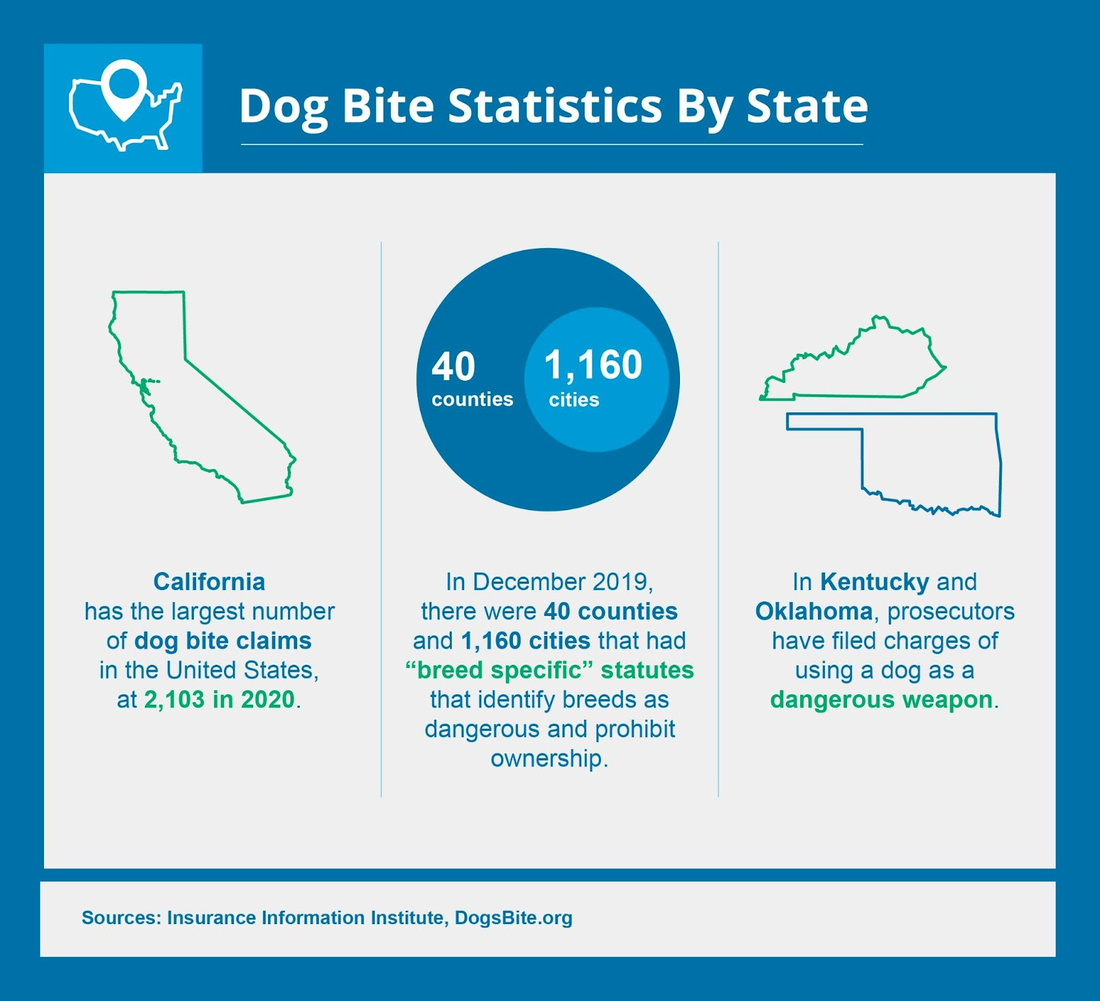
Across the country, state-level dog bite legislation and claims differ significantly.
Dog owners are liable for injuries caused by their pets in only 29 states.
In four states — Arkansas, Kansas, Mississippi, and North Dakota, there aren’t any dog bite laws at all.
By the end of 2019, 40 counties and 1,160 cities had “breed-specific” statutes. These statutes identified dangerous breeds and prohibited ownership of those breeds within city or area limits.
Of all city ordinances, 97% banned pit bulls.
In 2020, 17% of all fatal dog attacks led to meaningful criminal charges, only 8 out of 47 fatal attacks. This was 3% lower than the 15-year-average.
In 2020, California processed 2,103 claims, down from 2,396 the previous year.
Florida processed the second-highest number, at 1,235.
Between 2006 and 2010, dogs accounted for 77% of all reported animal bites in California.
In Florida, boys ages 6 to 14 were the most likely victims of dog bites.
Boys, in general, are over two times as likely to be bitten as girls of the same age.
Additional data from Florida has indicated that younger children are more likely to be bitten by familiar dogs. In contrast, children ages six and older are 3.6 times more likely to be bitten by an unfamiliar dog.
These results could be magnified due to the size and populations of California and Florida. Caution should be used when determining if certain states are more prone to dog attacks than others. It might be more prudent to interpret this state data as an indication of population. In other words, the more people in a state, the higher the chance of a dog bite attack.
Neither California nor Florida saw the highest number of dog-related deaths in 2020. Illinois held that title, with six deaths. Of those six deaths, pit bulls were responsible for five.
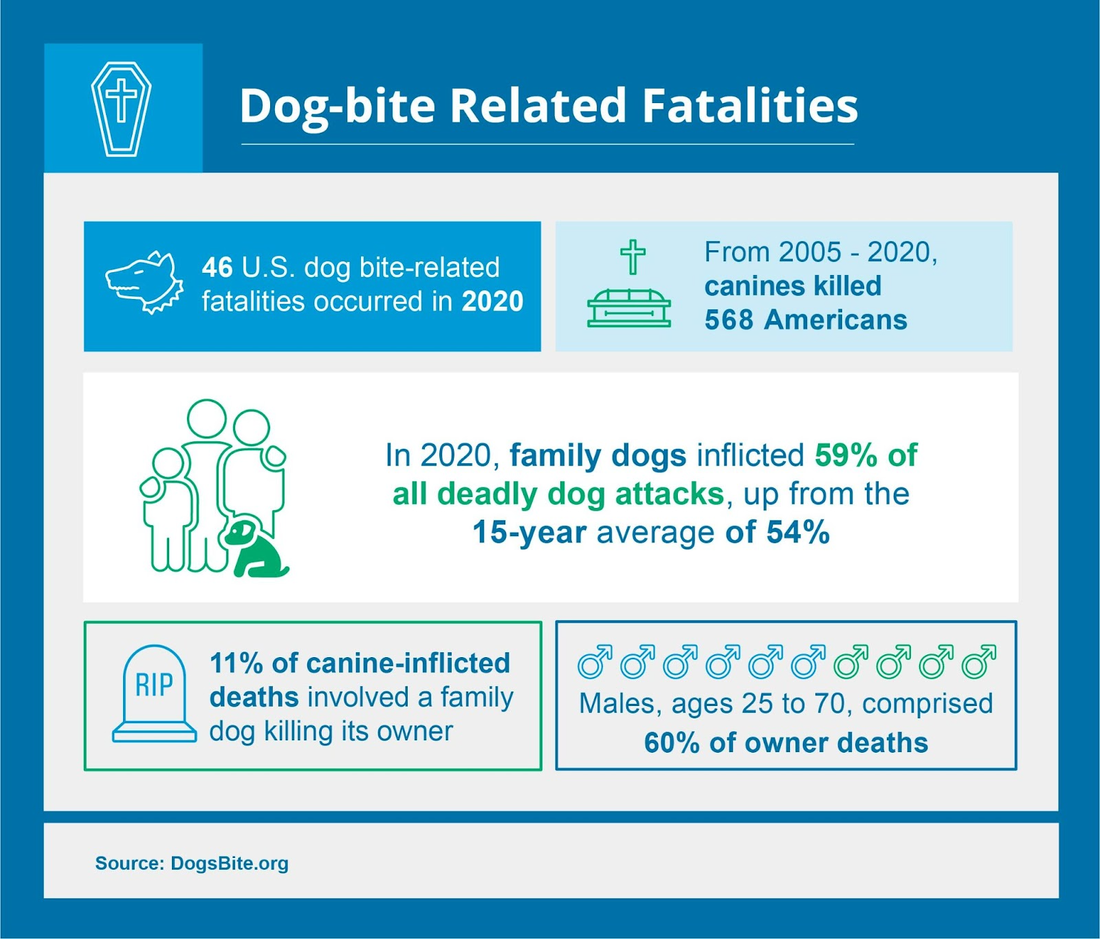
All dog bite attacks are traumatic. From mental anguish to deforming injuries, the risks can be severe. And, while rare, dogs do kill Americans every year.
From 2005 to 2020, dogs killed 568 Americans.
In 2020 alone, there were 46 dog bite-related fatalities.
Perhaps driven by the pandemic and lockdowns, children under 19 made up 40% of all fatal dog bite victims. Specifically, data results from that year showed:
33% (15 victims) were children below the age of 10
7% (3 victims) were between 10 and 18 years old
60% (28 victims) were adults ages 19 years and older
It is also interesting to note that in 2020:
Family dogs were responsible for 27 of the year’s deadly attacks. That constitutes 59% of all fatal dog attacks, up from the 15-year average of 54%.
11% of canine-inflicted deaths in 2020 involved a family dog killing its owner.
Males, ages 25 to 70, comprised 60% of these victims.
However, even without a fatality, dog bites can have huge ramifications, especially financially.
Over the past decade, the average insurance claim for dog bites has doubled, rising from $26,166 in 2010 to $50,245 in 2020.
Since 2003, the average cost per claim across the country has risen 162%.
In 2020 alone, homeowners’ insurers paid out $854 million in claims related to dog bites and dog-related injuries. That was up from $571 million paid in 2015.
The number of claims per year has only increased by 0.4% from 2003 to 2020. A typical year will see between 14,000 and 18,500 claims.
But, while that number wavers between those parameters, the value of those claims continues to increase.
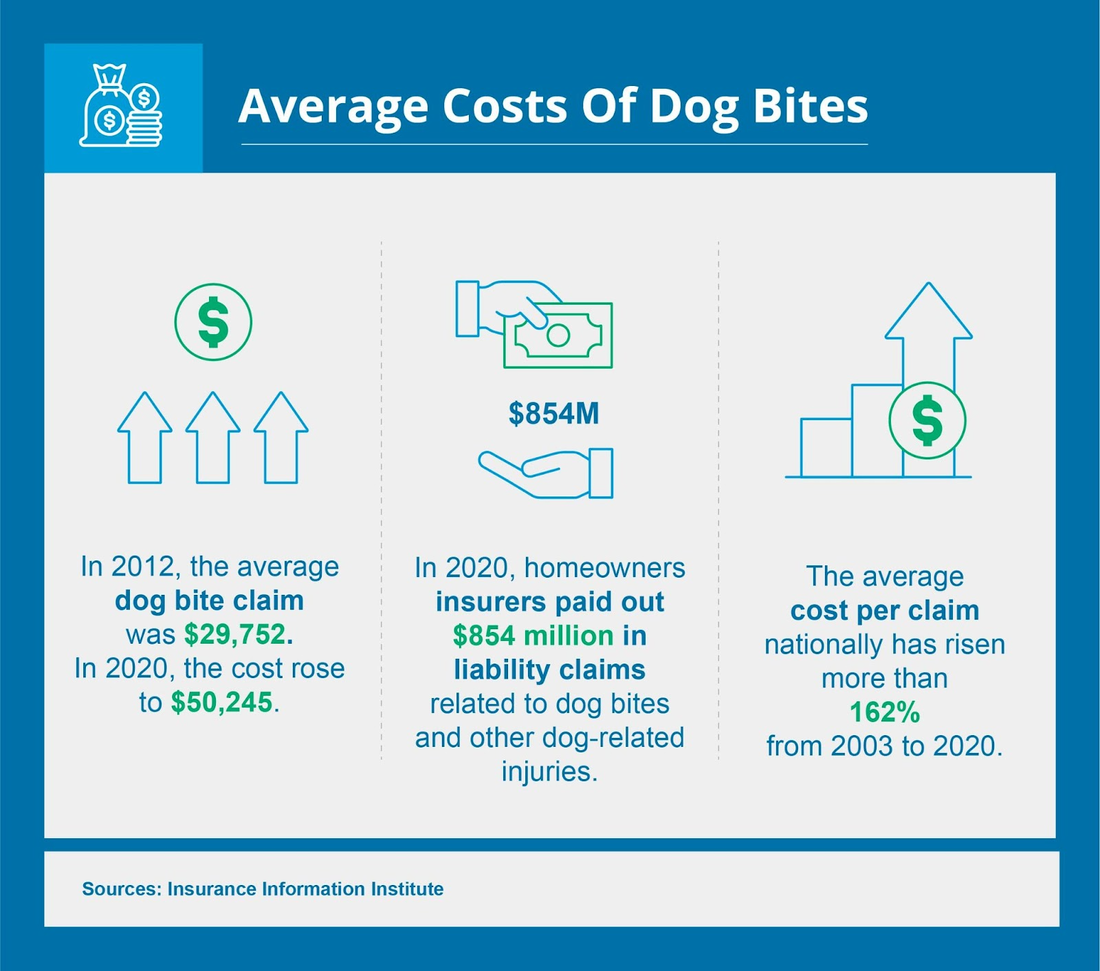
This highlights two major inferences. First, yearly dog attacks are, more or less, a stable occurrence, at least when looking at the number of dog bites and related insurance claims. On the other hand, claim costs per attack have risen independently of the number of those attacks.
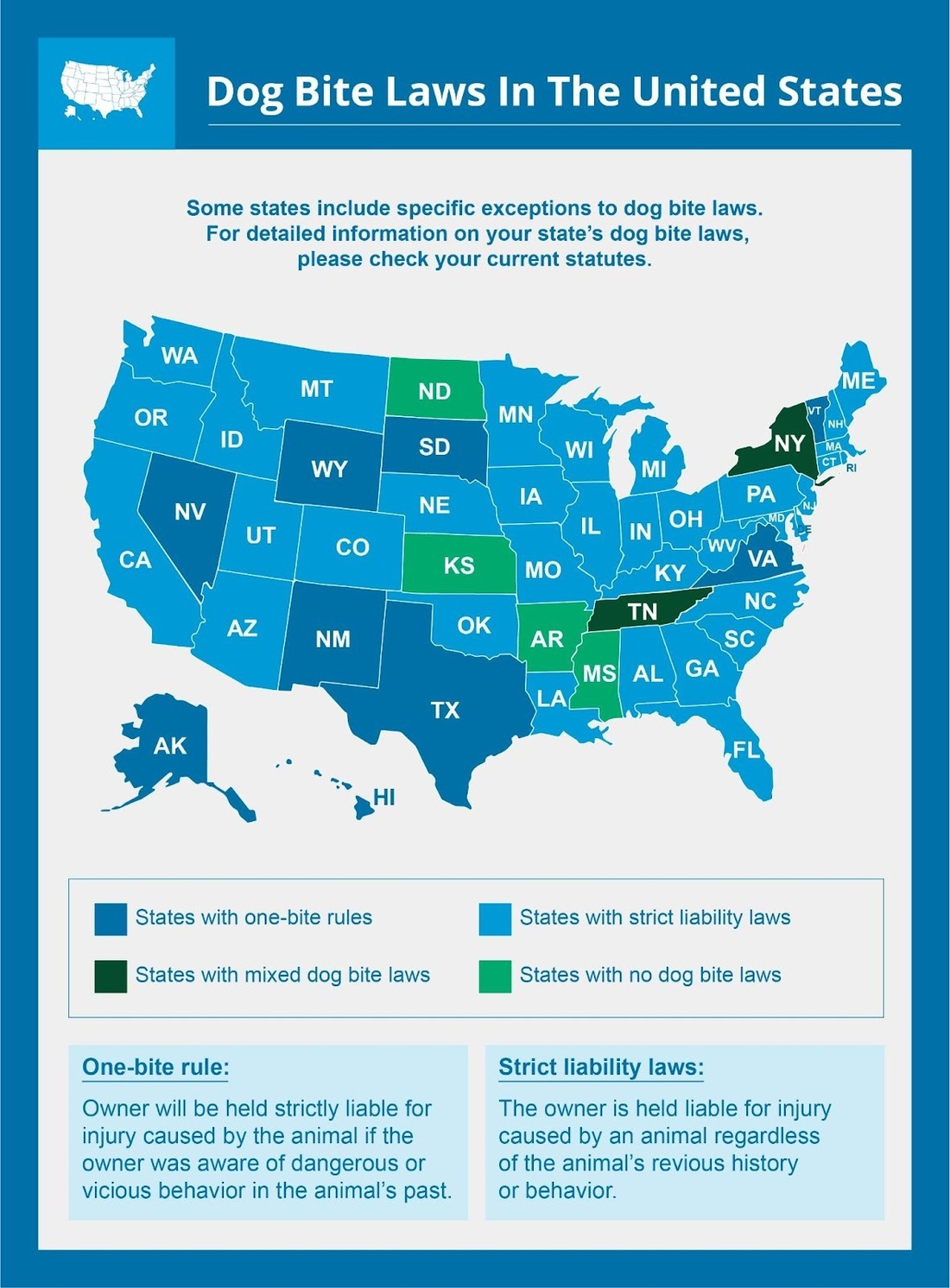
With this data in mind, knowing what qualifies as a dangerous dog is important, especially in legal and financial terms.
In simple terms, a dangerous dog often poses a threat to the public or other animals. This threat includes injury and death. Different states might refer to dangerous dogs with other terminology, including vicious dogs. These terms mean the same thing.
Forty-two states and the District of Columbia have statutes that regulate dangerous and violent dogs. Of the remaining states, only Alaska and Wyoming have the most general of dangerous dog laws.
In short, state laws vary across the country. The following states have no dangerous dog laws:
Arkansas
Connecticut
Indiana
Iowa
Kansas
Mississippi
Missouri
Utah
Wisconsin
Wyoming (has no definition for a dangerous dog, but it has statutes allowing for the euthanasia of and penalties for dogs that attack livestock)
Some states may also further qualify different distinctions of a dangerous dog. Some, like California, have a potentially dangerous classification. Others have terminology such as nuisance or menace added to their dangerous classifications. These classifications are used to emphasize specific risks for individual animals, though some breeds, including pit bulls, face breed-specific local statutes.
The process of a dog being officially declared dangerous varies from state to state. Depending on the state statute, a dangerous classification can arise from the following actions:
Unprovoked biting or attacking, or death, of a person or another animal
Having a history of attacking or biting people or other animals
Behaving in a manner that causes a person to feel an imminent threat
Dogs that are “at large”
Anything a justice of the peace declares dangerous
Colorado, Oregon, Pennsylvania, and Virginia declare dangerous dogs through criminal trials. And, in these states, owning or harboring a dangerous dog is a crime.
If a person owns a dangerous dog breed, they can face legal troubles. In Virginia and Pennsylvania, an owner must register a dangerous dog in an online registry. Other states require owners to ensure the dog is always muzzled when in public. Other requirements, such as confinement measures, identifying tattoos, neutering or spaying, and microchips, vary state by state.
Euthanasia can also be a result of a dangerous classification. Virginia, New Jersey, and Louisiana require all vicious dogs to be euthanized. Others mandate euthanasia after repeated attacks. Some, such as New Jersey, will call for a dangerous dog to be euthanized if the owner doesn’t appear to a mandated court date.
Even after a dangerous dog is euthanized, owners may still be subject to penalties. Depending on the attack, this can include felony charges, damage and personal injury liability, and various levels of monetary fines.
The injured party may also sue the owners of a dog that has attacked. Not only can they seek money for damages; these suits can also seek to declare the dog as dangerous. At this point, it is exposed to the aforementioned stipulations.
Laws vary across jurisdictions, as do the procedures. If a dog bites someone, it may be seized by animal control and held at a shelter. Suppose the dog isn’t normally dangerous, but a party is trying to have it declared as such because of a biting incident. In that case, evidence must be provided to prove the dog is not dangerous.
Depending on the jurisdiction, dangerous dogs may have to be removed from that jurisdiction completely. Others will order it to be euthanized immediately. The best course of action is to hire a lawyer and consult local dangerous dog statutes.
In general, a number of dangerous dog definitions are common among states. Typically, states have used the following definitions to declare dogs as dangerous:
Dogs that are trained in animal fighting
Dogs that aggressively bite or attack humans
Dogs that bite or attack unprovoked
Dogs that have killed people or other animals
Dogs that have menacingly chased people on public property
Dogs that cause an imminent threat through their behavior, without causing actual injury
In general, dogs that attack or kill will always be declared dangerous. There is also a high likelihood that aggressive dogs will also be declared dangerous. Though the specifics vary from state to state, the required actions and behaviors are common.
Some states, like Maryland, Ohio, and Delaware, further classify dogs as potentially dangerous or vicious if their attacks haven’t caused serious injury or death. Ohio, New Hampshire, and Massachusetts also have a “nuisance dog” classification. These classifications vary, but they include behaviors such as:
Barking for more than half an hour at night
Menacingly chase people
Growl or snap at cars
Disrupt a quiet and peaceful environment through interfering actions
You may wish to look at state and local ordinances to understand any dangerous dog rules that might affect you.
Several types of state-based laws can affect legal rulings in dog bite cases, from dangerous dog classifications to civil disputes. The one-bite rule is one such stipulation.
In short, the one-bite rule states that pet owners will only be liable for injuries caused by a dog if the owner knew that the dog was dangerous in the first place. In other words, if the dog has never shown such behavior before, the owners aren’t liable for damages. In addition, it falls to the injured person to prove the owners had existing knowledge of their dog’s level of danger.
Often seen as an antiquated statute, only 14 states permit the use of one-bite laws. These states are:
Alaska
Arkansas
Idaho
Kansas
Mississippi
Nevada
New Mexico
North Dakota
Oregon
South Dakota
Texas
Vermont
Virginia
Wyoming
On the other hand, more than half of all states have strict liability statutes regarding dog attacks. These statutes remove the burden of proof from the injured party. Specifically, they don’t have to prove existing knowledge that the dog was dangerous (aka the one-bite rule).
Each state includes various conditional exemptions for its policies. Some, like California, Colorado, and Wisconsin, provide exemptions to service dogs. Other states only cover bites, not other causes of damage, such as tripping or knocking over a cyclist. And many states feature exemptions for dogs that injure or kill intruders or parties that provoked the dog.
If you are an owner of a dangerous or potentially dangerous dog, there are steps you can take to protect yourself.
Most homeowners’ and renters’ insurance will feature dog bite liability coverage. This coverage usually ranges from $100,000 to $300,000. Depending on the severity of the attack, some dog bite claims might exceed this limit. At that point, the owner would be responsible for all additional damages and legal fees.
Of course, most of this can be avoided with responsible pet ownership. To ensure the best protection against dog bite lawsuits, take preemptive steps. The CDC recommends the following steps:
Ensure your neighborhood allows your dog breed.
Understand the dog’s history, especially with regards to other people and children.
Have your dog spayed or neutered. Intact dogs are three times more likely to attack.
Avoid aggressive games, and stick to non-aggressive and constructive play.
Enroll a potentially problematic dog in training and socialization classes.
If your dog has bitten or attacked someone and you are being sued, your first action should be to contact a lawyer. Look for local names known for handling dog bite cases. They should be knowledgeable about local and state statutes.
Pet liability is covered under most homeowners’ and renters’ insurance packages, but all dog owners should understand what it is and how it works.
Pet liability insurance provides financial protection against dog bite lawsuits. These can include accidental bodily injury and property damage lawsuits. Liability insurance covers the costs of medical care and property restoration.
Remember, pet liability insurance covers injuries and damages for other people and their property. It does not cover damage done by your pet to your own home, nor does it pay for any injuries sustained by you or any family members.
Bites and attacks are the most common incidents. However, pet liability insurance can also cover damages sustained from being knocked over or tripped as well as property damage to homes, vehicles, and other property somehow damaged by the dog.
Most policies have claim limits upwards of half a million dollars; as medical expenses can potentially surpass that, owners would have to cover the difference. Plus, additional costs for pain and suffering can be just as high as medical expenses.
Owners with problematic dogs might consider an umbrella policy to pay for any additional costs not covered by pet liability insurance.
Different breeds will determine the liability limits. Most dogs will be able to meet coverage requirements for full coverage, but some policies ask for specific requirements to obtain coverage. These can include properly fenced yards, up-to-date vaccines, and proof of being spayed or neutered.
Some breeds, such as pit bulls, are likely to be considered dangerous even without a previous history of violence. In these instances, insurance providers can place a smaller coverage limit on the policy. This can also be done for dogs with a history of violence and for dogs that have been trained for guard and attack duty.
Most people never expect their dog to bite, but every dog can bite and do damage, even without a history of aggression and violence.
Ensure your dog is trained, understand what stresses or provokes them, and make sure they’re supervised around new people and children.
If you’ve experienced a dog bite or are an owner whose dog bit someone, you may want to seek legal advice.
